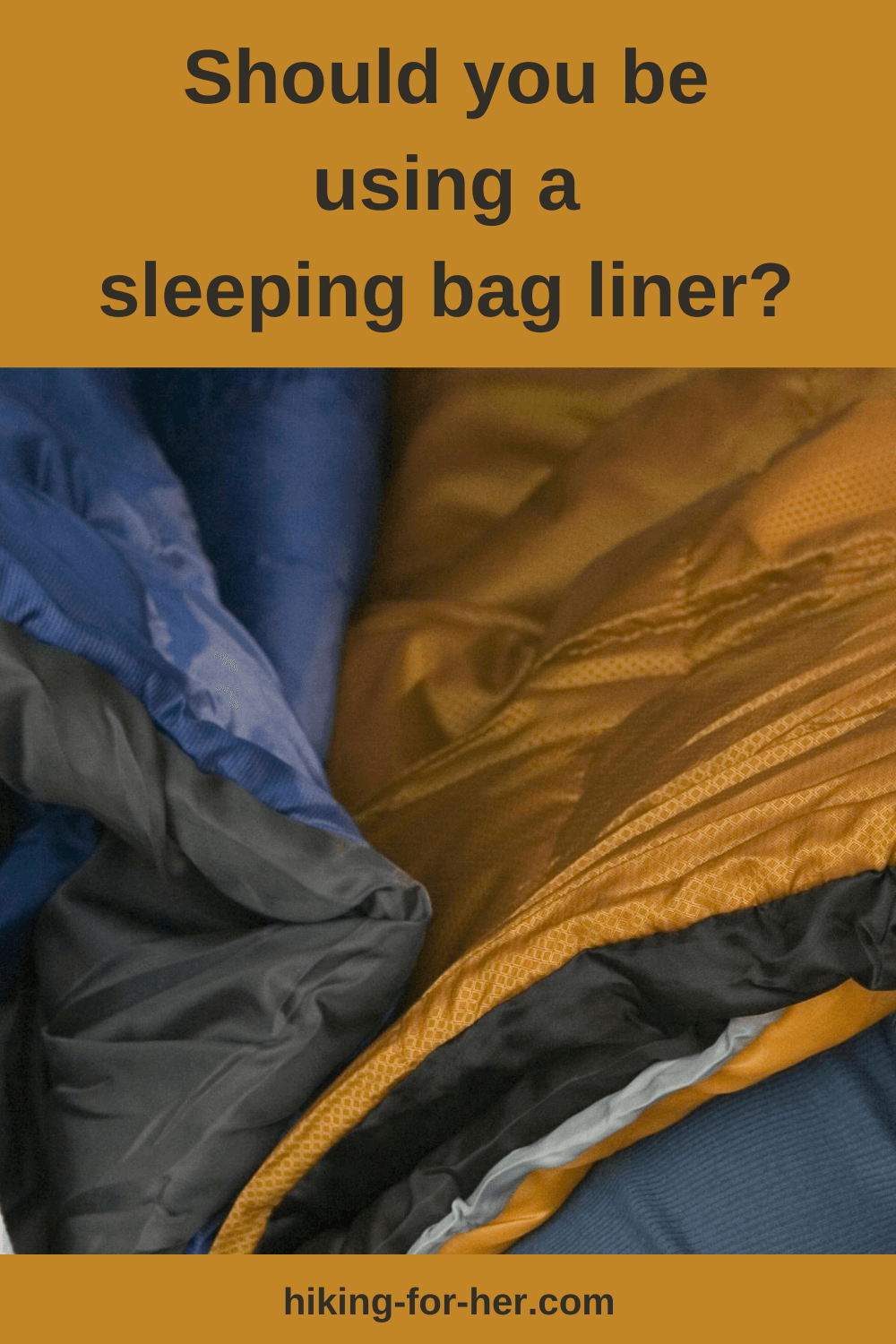
Best Sleeping Bag Liner -
Do You Need One?
By Diane Spicer
A sleeping bag liner or "insert" does just what it promises: it lines your sleeping bag, keeping the inside from touching you.
Think of a garbage bag inside a garbage can.
But why do you need this piece of hiking gear?
Maybe you don't!
Take a look at the variables that go into deciding whether or not to purchase, and deploy, a sleeping bag liner.
Or keep things fast and easy:
- just take my word for it and buy the one I carry on backpacking trips.
- This one is also a winner, and a lower price point.
Sleeping bag liner variables
so you can choose the best one
Choosing a great sleeping bag is a tough job.
- Read Hiking For Her's tips on how to choose the best backpacking sleeping bags.
- Read a review of the bag I finally bought.
- Or look over these tips for using a backpacking quilt.
In contrast, choosing a sleeping bag liner is really straightforward.
It's a tug of war between comfort and price!
Maybe you'll have to split the difference to make a decision.
But if you have the luxury of a plump slush fund to spend on backpacking and camping gear, the comfort factor will rise as you pay for a more robust liner.
Let's take a look at comfort first.
 The right sleeping bag liner can buy you a great night's rest on your next hiking trip!
The right sleeping bag liner can buy you a great night's rest on your next hiking trip!
Sleeping bag liner comfort
As a backpacker (current or aspiring), you realize that sleep is essential to a safe, enjoyable backpacking trip.
Here's the non-negotiable fact as darkness falls and possibly you are facing wind gusts, falling temperatures, pounding rain, hail, sleet, snow or whatever other antics Mother Nature wants to throw at you:
You can't sleep if you're cold.
A sleeping bag liner is built to slide inside your current sleeping bag and do two nice things for you:
- Increase the temperature rating of your bag by several degrees, to keep you toasty warm (or at least toastier than life without the liner).
- Keep the inside of the bag away from your sweaty, clammy, dirty skin, thereby extending the overall lifespan of your pricey sleeping bag as you drift off to sleep.
Weight versus comfort
A liner is an ideal solution to the problem of weight -vs- comfort which all backpackers face, because for a few extra ounces you can get away with a less expensive, (possibly) heavier sleeping bag without sacrificing your comfort.
More good news:
Bag liners are easy to machine wash and dry time and time again, but sleeping bags are not.
So why not go the easy route and use a liner?
Not convinced you need a
sleeping bag liner?
If staying warmer isn't a factor for you, consider this about using a sleeping bag liner:
- It feels nice against your skin as the cotton, silk, or soft polyester wicks away moisture and traps your body heat in your bag.
Comfort is no small thing when you've been out on the trail for a few days.
And here's something you might not have considered:
Hygiene concerns after acts of intimacy involving body fluids with your significant other hiking partner are another reason to consider a liner.
- Clean up the odors and residues with a quick trip through the washing machine, but spare your much more expensive sleeping bag from frequent soap, hot water, friction, and harsh drying cycles.
Sleeping bag liner prices
Money is definitely a factor in the term "price", but for a backpacker, comfort also comes with a price: weight.
- More muscle power is required for a heavier pack, thus more fuel in the form of food must be carried.
- That costs more money and effort, thus increasing the "price" of your backpacking plans.
Let's tackle the monetary cost involved in choosing a bag liner first.
The damage a liner can do
to your hiking budget
The material you select for your bag liner matters to your bottom line.
A silk bag liner is going to set you back more than a polyester liner.
- This silk liner costs $65US at the time of this writing.
- This microfiber polyester liner costs $28US
Wow, that's a big difference!
So that's why you need to ponder whether you really need one of these liners.
- Does all of your backpacking occur in warm climates?
- Do you schedule all of your backpacking trips for warm summer months, when extra warmth is not required?
Maybe you can get away with using just a bag liner, and skip the whole "what is the best sleeping bag for me" ordeal.
Think of the weight and space you'll save!
But slow down and consider this
What conditions are you likely to face in your backpacking destination?
Climatology can give you a general idea.
Reading the weather forecasts before you leave, also good information.
If you determine after your research that it's likely that you're going to be caught out in wet, windy or unpredictable conditions, packing a liner to augment your sleeping bag makes good sense.
But there's more to consider.
- What if your gear gets soaked by an unexpected tumble into a stream?
- A liner might help you get through an uncomfortable night without flirting with hypothermia.
Important comfort note for female hikers
Here's something big for female backpackers to ponder:
- Are you a "cold" sleeper?
Most women are, compared with men.
You might cherish those extra degrees of comfort inside your sleeping bag, because they spell the difference between shivering all night versus falling into a deep restful sleep.
Unless you provide your own heat, as in menopausal hot flashes. Read this instead.
More to love about
a sleeping bag liner
Liners usually come with a stuff sack, and because they're soft and pliable you can squish them into any dead space in your pack - including inside gear that tends to rattle and roll (cooking pots, lookin' at you).
Be sure the sack gets encased in a plastic bag or waterproof sack along with other survival gear.
- Great idea if you're doing a lot of stream crossings!
More ways to use a liner
Here's another great feature of carrying a sleeping bag liner:
I use my liner as a pillow when I don't need to be inside of it.
- The softness and warmth of the liner material is very comforting on my face and neck.
- I'm a side sleeper, but you could also use the rolled up liner under your neck or knees if you sleep on your back.
One last idea to justify the expense:
- Carry the liner year round on day hikes, as an extra "ten essentials" to buy yourself a small margin of safety if you need to spend an unplanned night out of doors.
- But only if it's lightweight!
Why carry that extra weight?
Now to address the "extra weight" price.
Ultralight hikers would be scandalized by my suggestion to carry a liner AND a sleeping bag, because liners range between 5 and 14 ounces.
- That's creeping dangerously close to one pound, which is sacrilege!
To them, I say this:
Sleep is priceless, and I'm willing to sacrifice weight in other areas in order to guarantee a deep sleep cycle.
It makes me stronger, and thus safer, the next day on the trail.
To each, her own comfort gear.
This 7 ounce sleeping bag liner is not going to make or break your gear list unless you are an extreme ounce counter.
And if it makes the difference between a restful night and a cold night, ditch 7 ounces elsewhere on your gear list.

Tips on how to buy a sleeping bag liner
Be sure to select the right liner to match your bag:
- mummy or cocoon style
- rectangular
Otherwise you'll have too much, or too little, fabric, which creates uneven thermal conditions.
- Not to mention bunching and pulling
And don't forget to hunt for the fabric choice you determined above first, then look at the dimensions and cut.
Get in carefully!
Pay attention to how you enter the liner.
Some liners are just big sacks with a top opening, so you might have to squirm and wiggle a bit to get into them.
- But all of that muscle action will create body heat, which you will efficiently trap!
Other liners are designed to open up wide to give you a lot of space to crawl and thrash around in as you sleep.
Tip:
If there's a draw cord, you might want to cinch it down to keep your heat in where it matters.
Or use it to vent the liner at appropriate hot flash intervals, if you're a menopausal hiker.
And your answer is?
So how do you feel about sleeping bag liners now?
Only you can decide whether the extra ounces make sense for your budget, your back, and your sleeping needs.
But I think you can see that I come down squarely in the "buy the darn liner already!!" camp.
Recap on bag liner benefits
To recap why I'm a fan, here's what a sleeping bag liner gives you:
- Several extra degrees of warmth that will translate directly into restful sleep
- A washable way to extend the life of your sleeping bag from wear and tear
- Softness and moisture wicking and protection from your sweat encrusted trail dirt, so it won't get embedded in your high tech sleeping bag fabric
- Versatility: use it alone, on top of your sleeping bag, or use it as intended inside your bag
- Margin of safety: carry it on day hikes as part of your survival kit
So it won't surprise you to know that I own one of these little beauties!
Home page > Best Hiking Gear >
Best Sleeping Bag Liner
|
I get emails all the time about what I wear, eat, carry and love to use on the trail. That's
why I provide affiliate links to you: the best gear that I use myself and have seen used by other hikers is instantly
available for your consideration, and the gear company sends a few
pennies per dollar to this reader-supported hiking website. There is no added cost to you! Everyone ends up a winner: Great gear for you, strong gear companies, and more free hiking tips for everyone. Thanks very much for your support. It's warmly and sincerely appreciated. It also helps send these hiking tips to all your virtual trail buddies around the globe. |
 |


